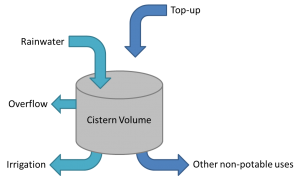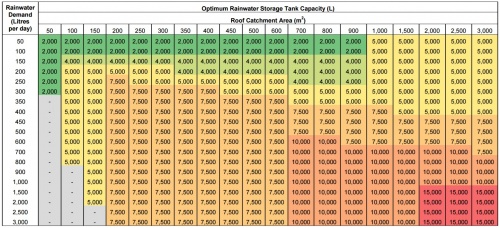Difference between revisions of "Rainwater harvesting: Sizing and modeling"
Jenny Hill (talk | contribs) |
Jenny Hill (talk | contribs) |
||
| Line 3: | Line 3: | ||
===Simple=== | ===Simple=== | ||
Five percent of the average annual yield can be estimated: | Five percent of the average annual yield can be estimated: | ||
| − | + | :<math>Y_{0.05} = A \times C_{vol, A}\times R_{a} \times e \times 0.05</math> | |
where: | where: | ||
{{plainlist| | {{plainlist| | ||
Revision as of 13:42, 17 August 2017
Simple[edit]
Five percent of the average annual yield can be estimated:
where:
- Y0.05 = Five percent of the average annual yield (L)
- A = The catchment area (m2)
- Cvol, A = The annual runoff coefficient for the catchment
- Ra = The average annual rainfall depth (mm)
- e = The efficiency of the pre-storage filter
Filter efficiency (e) can be reasonably estimated as 0.9 pending manufacturer’s information.
In a study of three sites in Ontario, STEP found the annual Cvol, A of the rooftops to be around 0.8 [1]. This figure includes losses to evaporation, snow being blown off the roof, and a number of overflow events.
Five percent of the average annual demand can be estimated:
$$D_{0.05} = P_{d} \times n\times 18.25$$
Where:
- D0.05 = Five percent of the average annual demand (L)
- Pd = The daily demand per person (L)
- n = The number of occupants
Then the following calculations are based upon two criteria:
- A design rainfall depth is to be captured entirely by the RWH system.
- The average annual demand (D) is greater than the average annual yield (Y) from the catchment.
- When Y0.05/ D0.05 < 0.33, the storage volume required can be estimated:
- VS = A × Cvol × Rd × e
- VS = Storage volume required (L)
- A = The catchment area (m2)
- Cvol, E = The design storm runoff coefficient for the catchment
- Rd = The design storm rainfall depth (mm), and
- e = The efficiency of the pre-storage filter.
- Careful catchment selection means that the runoff coefficient, for a rainstorm event (Cvol, E) should be 0.9 or greater.
When 0.33 < Y0.05/ D0.05< 0.7, the total storage required can be estimated by adding Y0.05:
Total storage = VS + Y0.05
STEP Rainwater Harvesting Tool[edit]
The Sustainable Technologies Evaluation Program have produced a rainwater harvesting design and costing tool specific to Ontario. The tool is in a simple to use Excel format and is free to download.
Rainwater Harvesting Tool
STEP Treatment Train Tool[edit]
Once the size of cistern has been determined, it can easily be modeled in many open source and proprietary applications. For planning purposes, a RWH system could be integrated into a site plan using STEP's Treatment Train Tool. In a typical configuration:
- The catchment (roof) would be 100% impervious
- The rainwater harvesting system would be a 'Storage' Element with the following properties:
- Storage type = No removal
- Lined
- Underlying soil = doesn't matter, can ignore
- Evaporation factor = 0
- Suction head (mm) = 0
- Saturated conductivity (mm/hr) = 0
- Initial soil moisture deficit (fraction) = 0
- The dimensions of the rainwater cistern can be placed into the fields:
- Bottom elevation (m)
- Maximum depth (m)
- Initial water depth (m)
- The Curves table is designed to accommodate ponds of roughly conical dimensions. A rainwater cistern is usually cuboid or cylindrical in shape, so that the area (m2) will remain the same throughout the depth.



